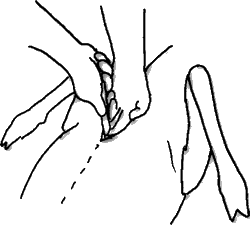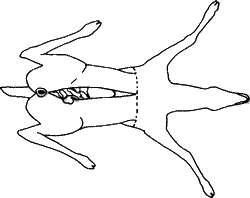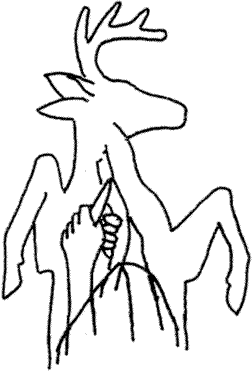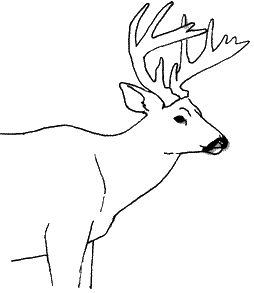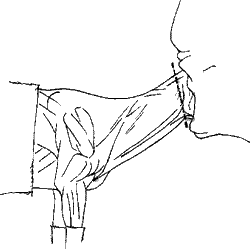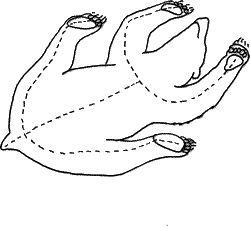| "The key to sucess is to always prepare in advance for an upcomming event." |
| Field Guide |
Before the Hunt Get your body in shape. Practice lifting techniques and tune-up your heart, lungs and muscles for carrying heavy loads over rough terrain. Get your brain in shape. Learn more about butchering and meat care from your local library, butcher, or Fish & Game biologist. Get your gear in shape. Collect and test all of the equipment you need for butchering, hauling, and caring for your meat. Here's a short list to consider: skinning knife, butchering knife, trimming knife, sharpener, bone saw, tarp, heavy-duty game bags, plastic bags, heavy-duty backpack, paper towels, rope, and a first-aid kit. Get your freezer in shape. Plan how you will get the meat home. Contact local butcher shops or get your equipment ready for home butchering. Be sure you have enough room in your freezer or someone to give the meat to when you return. Skinning Your Mount for Taxidermy - Field Dressing With the deer on its back, make a shallow cut through the skin just below the breastbone. Make sure that you start your cut well away from the brisket, allowing plenty of uncut skin for your shoulder mount. Insert two fingers of the free hand, cradling the blade, to hold the skin up and away from the entrails.
Cut deeply around the rectum, being careful not to cut off or puncture the intestine. Pull to make sure the rectum is separated from tissue connecting it to the pelvic canal. Pull the rectum out and tie string tightly around it to prevent droppings from touching the meat. Lift the animal's back quarter a bit, reach into the front of the pelvic canal, and pull the intestine and connected rectum into the stomach area. If you want to make a full shoulder mount, do not cut open the chest cavity. Cut the diaphragm away from the ribs all the way to the backbone area. Reach into the forward chest cavity, find the esophagus and wind pipe, cut them off as far up as possible and pull them down through the chest.
Caping, the process of skinning out a trophy animal for taxidermy, is best left to the taxidermist. Their experience skinning, especially the delicate nose, mouth, eyes, and ears is invaluable toward producing a quality mount. Damage to a hide is costly to repair. Some types of damage simply cannot be "fixed" by the taxidermist. Many trophies are ruined in the first few hours after death. As soon as the animal dies, bacteria begins to attack the carcass. Warm, humid weather accelerates bacteria growth. In remote areas, or areas not near your taxidermist, a competent person may be required to cape out the hide in order to preserve it. Every taxidermist has a preferred method of caping (or skinning) a hide. Contact your taxidermist prior to your hunt in order to get instructions on their caping requirements. However, the following techniques are generally acceptable. Caping (Skinning) for a Shoulder Mount With a sharp knife, slit the hide circling the body behind the shoulder at approximately the midway point of the rib cage behind the front legs. Slit the skin around the legs just above the knees. An additional slit will be needed from the back of the leg and joining the body cut behind the legs.
These cuts should allow ample hide for the taxidermist to work with in mounting. Remember, the taxidermist can cut off excess hide, but he can't add what he doesn't have.
When skinning a trophy to be mounted, don't cut into the brisket (chest) or neck area. If blood gets on the hide to be mounted, wash it off with snow or water as soon as possible. Avoid dragging the deer out of the woods with a rope. Place it on a sled, a rickshaw, or a four-wheeler. The rope, rocks, or a broken branch from a deadfall can easily damage the fur or puncture the hide. If you do need to drag it our with a rope, attach the rope to the base of the antlers and drag your trophy carefully. There are two major methods of skinning for a large life-size mount such as deer, elk, or bear for taxidermy. These methods are the flat incision and the dorsal method.
The flat incision is used for rug mounts and for a variety of poses. Make these slits (cutting the feet free from the carcass) and pull the skin off the carcass. The head is detached as with the shoulder mount.
If you can't take your hide immediately to a taxidermist, freeze it to your taxidermist's specifications. The dorsal method of skinning involves a long slit down the back (from the tail base up into the neck). The carcass is skinned as it is pulled through this incision. The feet / hooves and the head are cut from the carcass as with a shoulder mount explained later. Only use this method with approval and detailed instructions from your taxidermist. Use this method only when the skin can be frozen quickly after skinning.
Animals, coyote sized or smaller, should not be skinned unless by a professional. Don't gut the animal. Small mammals, especially carnivores, will spoil quickly because of their thin hide and bacteria. If you can't take the small game animal immediately to a taxidermist, as soon as the carcass cools completely, put it in a plastic bag and freeze it. With the epidemic of rabies evident in many areas of the country, take every safety measure necessary when handling your game. Birds Do not gut the bird. Rinse any blood from the feathers with water. Take the bird immediately to your taxidermist or freeze it. Put the bird into a plastic bag for freezing, being careful not to damage the feathers, including the tail. If the bird's tail feathers do not fit in the bag, do not close it. Fish Do not gut your fish. If you cannot take your fish immediately to a taxidermist, wrap it in a very wet towel and put it in a plastic bag, making sure all the fins are flat against the fish's body (to prevent breakage) and freeze it. A fish frozen in this manner can safely be kept in the freezer for months. Note: A fish will lose its coloration shortly after being caught. A good color photograph immediately after the catch may enable the taxidermist to duplicate the natural color tones of that particular fish. Tips * Always have appropriate tags with your trophies when you take them to your taxidermist. Federal Law and can not be mounted unless with special Federal permit. taxidermist or freezer, ask your taxidermist about techniques to skin out the entire cape (including the head) and salting the hide. This is the only method in remote locations that can preserve your hide for later mounting. http://www.learn-taxidermy.com/skinning_taxidermy.htm#flat |
